Nursing: Applying Florence Nightingale's Environmental Theory Analysis
VerifiedAdded on 2021/04/21
|8
|1475
|22
Essay
AI Summary
This nursing assignment analyzes Florence Nightingale's environmental theory, emphasizing the impact of environmental factors on patient health and recovery. The essay explores the theory's core principles, including the importance of sanitation, hygiene, and a positive psychological environment. It examines how nurses can enhance patient outcomes by addressing physical, social, spiritual, and psychological components. The assignment references supporting studies and highlights the theory's continued relevance in modern nursing practice, particularly in infection control and patient care. The essay concludes by reinforcing the significance of environmental factors in shaping health outcomes and guiding contemporary nursing practices. The provided references support the claims made in the essay, providing evidence for the theory's impact.
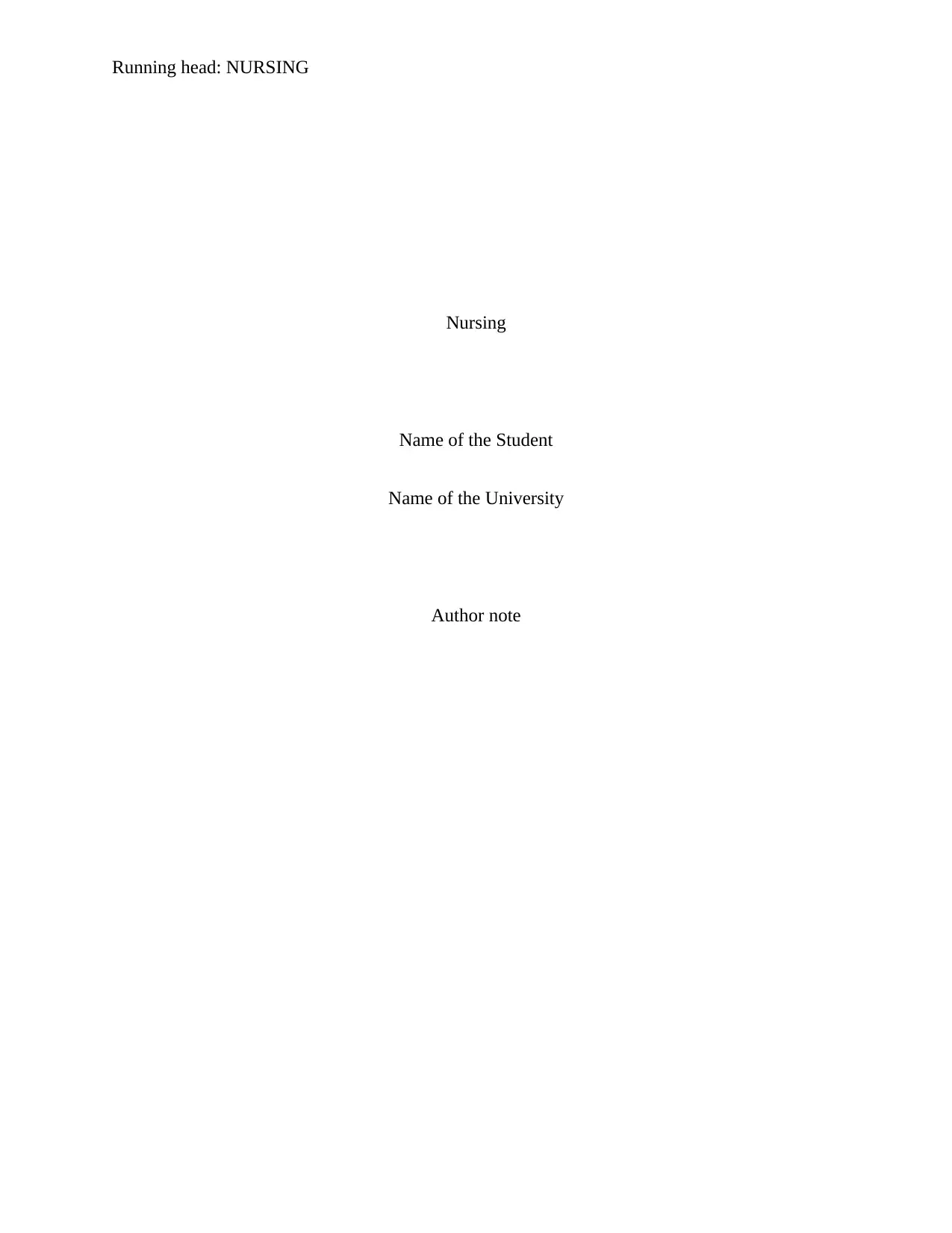
Running head: NURSING
Nursing
Name of the Student
Name of the University
Author note
Nursing
Name of the Student
Name of the University
Author note
Paraphrase This Document
Need a fresh take? Get an instant paraphrase of this document with our AI Paraphraser
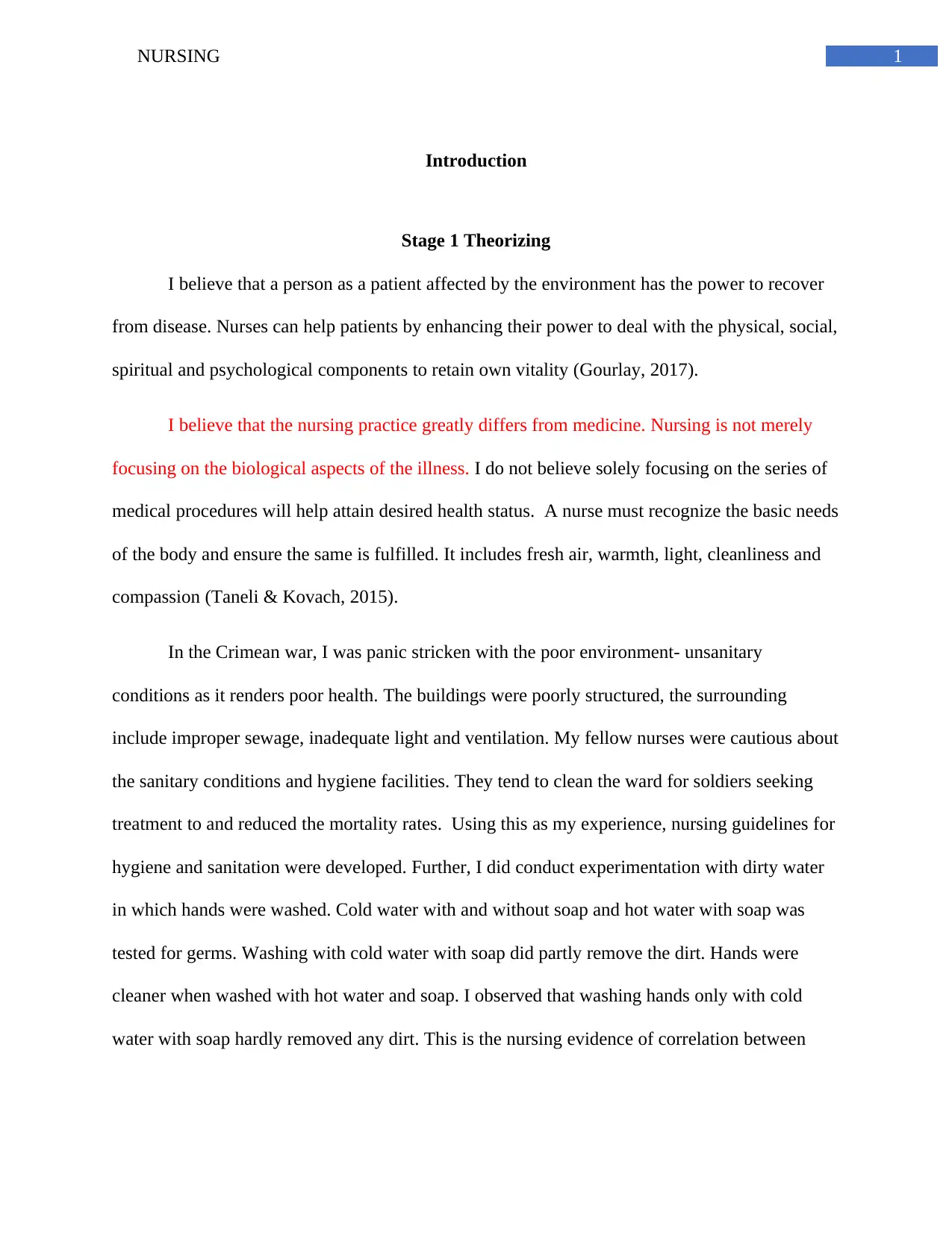
1NURSING
Introduction
Stage 1 Theorizing
I believe that a person as a patient affected by the environment has the power to recover
from disease. Nurses can help patients by enhancing their power to deal with the physical, social,
spiritual and psychological components to retain own vitality (Gourlay, 2017).
I believe that the nursing practice greatly differs from medicine. Nursing is not merely
focusing on the biological aspects of the illness. I do not believe solely focusing on the series of
medical procedures will help attain desired health status. A nurse must recognize the basic needs
of the body and ensure the same is fulfilled. It includes fresh air, warmth, light, cleanliness and
compassion (Taneli & Kovach, 2015).
In the Crimean war, I was panic stricken with the poor environment- unsanitary
conditions as it renders poor health. The buildings were poorly structured, the surrounding
include improper sewage, inadequate light and ventilation. My fellow nurses were cautious about
the sanitary conditions and hygiene facilities. They tend to clean the ward for soldiers seeking
treatment to and reduced the mortality rates. Using this as my experience, nursing guidelines for
hygiene and sanitation were developed. Further, I did conduct experimentation with dirty water
in which hands were washed. Cold water with and without soap and hot water with soap was
tested for germs. Washing with cold water with soap did partly remove the dirt. Hands were
cleaner when washed with hot water and soap. I observed that washing hands only with cold
water with soap hardly removed any dirt. This is the nursing evidence of correlation between
Introduction
Stage 1 Theorizing
I believe that a person as a patient affected by the environment has the power to recover
from disease. Nurses can help patients by enhancing their power to deal with the physical, social,
spiritual and psychological components to retain own vitality (Gourlay, 2017).
I believe that the nursing practice greatly differs from medicine. Nursing is not merely
focusing on the biological aspects of the illness. I do not believe solely focusing on the series of
medical procedures will help attain desired health status. A nurse must recognize the basic needs
of the body and ensure the same is fulfilled. It includes fresh air, warmth, light, cleanliness and
compassion (Taneli & Kovach, 2015).
In the Crimean war, I was panic stricken with the poor environment- unsanitary
conditions as it renders poor health. The buildings were poorly structured, the surrounding
include improper sewage, inadequate light and ventilation. My fellow nurses were cautious about
the sanitary conditions and hygiene facilities. They tend to clean the ward for soldiers seeking
treatment to and reduced the mortality rates. Using this as my experience, nursing guidelines for
hygiene and sanitation were developed. Further, I did conduct experimentation with dirty water
in which hands were washed. Cold water with and without soap and hot water with soap was
tested for germs. Washing with cold water with soap did partly remove the dirt. Hands were
cleaner when washed with hot water and soap. I observed that washing hands only with cold
water with soap hardly removed any dirt. This is the nursing evidence of correlation between
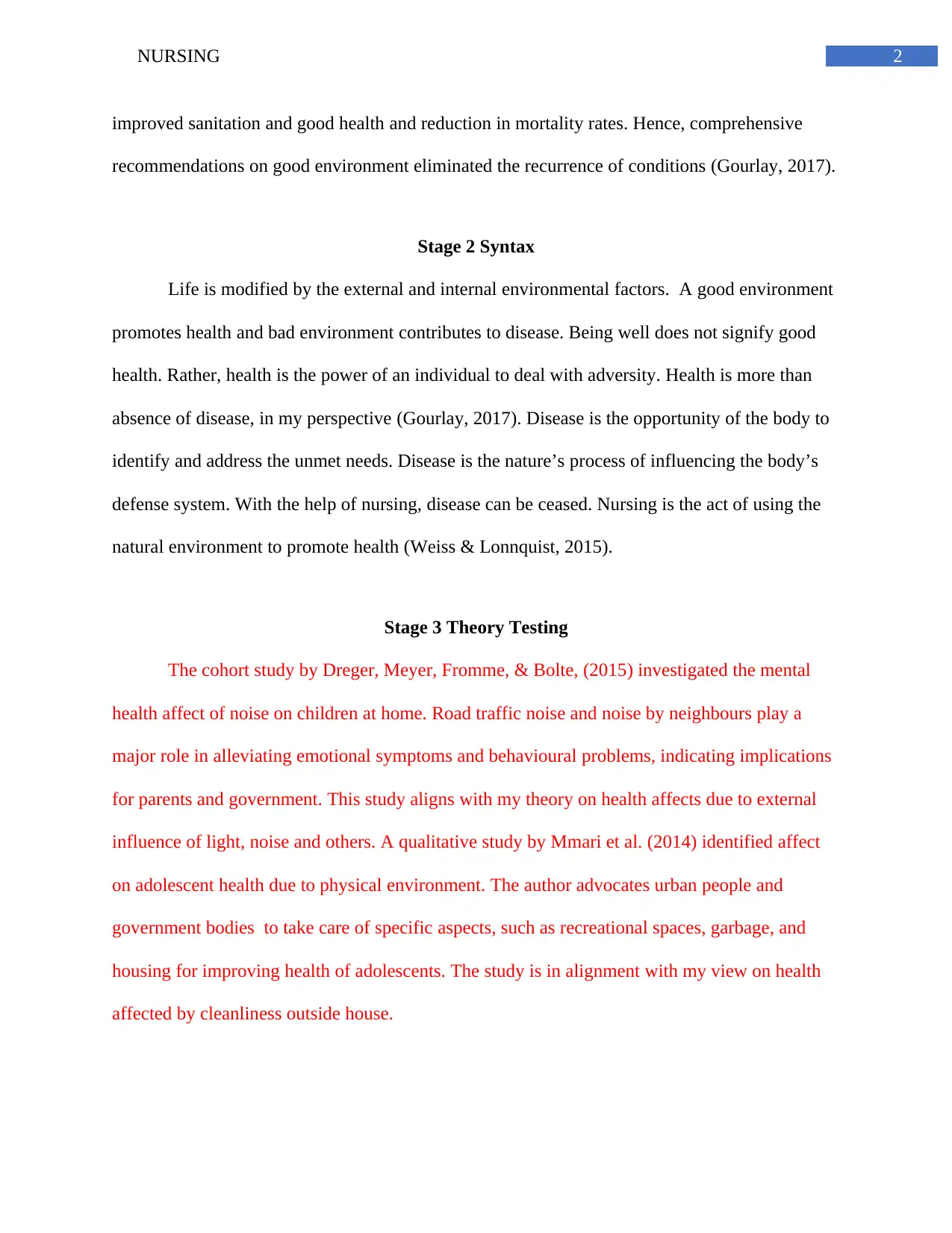
2NURSING
improved sanitation and good health and reduction in mortality rates. Hence, comprehensive
recommendations on good environment eliminated the recurrence of conditions (Gourlay, 2017).
Stage 2 Syntax
Life is modified by the external and internal environmental factors. A good environment
promotes health and bad environment contributes to disease. Being well does not signify good
health. Rather, health is the power of an individual to deal with adversity. Health is more than
absence of disease, in my perspective (Gourlay, 2017). Disease is the opportunity of the body to
identify and address the unmet needs. Disease is the nature’s process of influencing the body’s
defense system. With the help of nursing, disease can be ceased. Nursing is the act of using the
natural environment to promote health (Weiss & Lonnquist, 2015).
Stage 3 Theory Testing
The cohort study by Dreger, Meyer, Fromme, & Bolte, (2015) investigated the mental
health affect of noise on children at home. Road traffic noise and noise by neighbours play a
major role in alleviating emotional symptoms and behavioural problems, indicating implications
for parents and government. This study aligns with my theory on health affects due to external
influence of light, noise and others. A qualitative study by Mmari et al. (2014) identified affect
on adolescent health due to physical environment. The author advocates urban people and
government bodies to take care of specific aspects, such as recreational spaces, garbage, and
housing for improving health of adolescents. The study is in alignment with my view on health
affected by cleanliness outside house.
improved sanitation and good health and reduction in mortality rates. Hence, comprehensive
recommendations on good environment eliminated the recurrence of conditions (Gourlay, 2017).
Stage 2 Syntax
Life is modified by the external and internal environmental factors. A good environment
promotes health and bad environment contributes to disease. Being well does not signify good
health. Rather, health is the power of an individual to deal with adversity. Health is more than
absence of disease, in my perspective (Gourlay, 2017). Disease is the opportunity of the body to
identify and address the unmet needs. Disease is the nature’s process of influencing the body’s
defense system. With the help of nursing, disease can be ceased. Nursing is the act of using the
natural environment to promote health (Weiss & Lonnquist, 2015).
Stage 3 Theory Testing
The cohort study by Dreger, Meyer, Fromme, & Bolte, (2015) investigated the mental
health affect of noise on children at home. Road traffic noise and noise by neighbours play a
major role in alleviating emotional symptoms and behavioural problems, indicating implications
for parents and government. This study aligns with my theory on health affects due to external
influence of light, noise and others. A qualitative study by Mmari et al. (2014) identified affect
on adolescent health due to physical environment. The author advocates urban people and
government bodies to take care of specific aspects, such as recreational spaces, garbage, and
housing for improving health of adolescents. The study is in alignment with my view on health
affected by cleanliness outside house.
⊘ This is a preview!⊘
Do you want full access?
Subscribe today to unlock all pages.

Trusted by 1+ million students worldwide
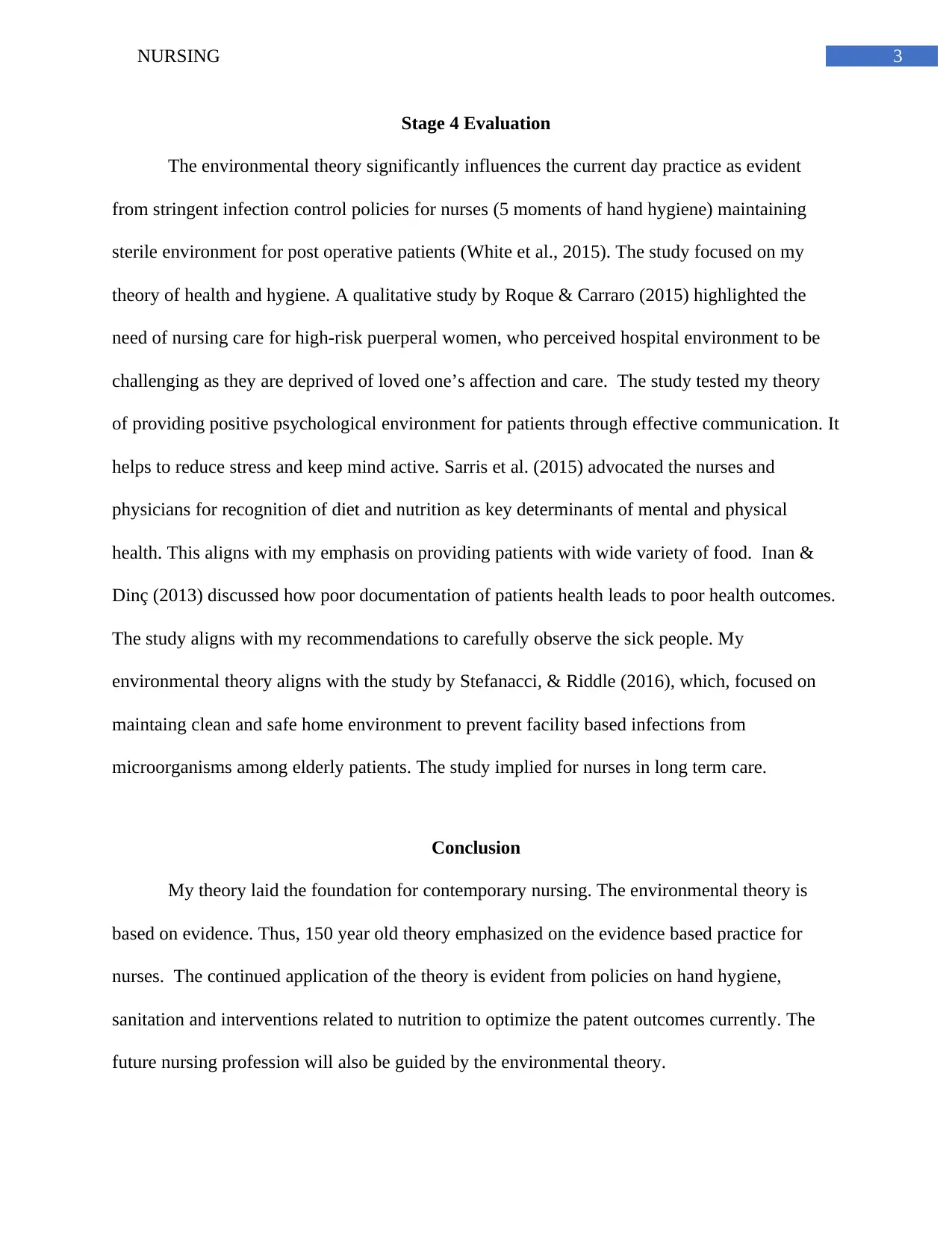
3NURSING
Stage 4 Evaluation
The environmental theory significantly influences the current day practice as evident
from stringent infection control policies for nurses (5 moments of hand hygiene) maintaining
sterile environment for post operative patients (White et al., 2015). The study focused on my
theory of health and hygiene. A qualitative study by Roque & Carraro (2015) highlighted the
need of nursing care for high-risk puerperal women, who perceived hospital environment to be
challenging as they are deprived of loved one’s affection and care. The study tested my theory
of providing positive psychological environment for patients through effective communication. It
helps to reduce stress and keep mind active. Sarris et al. (2015) advocated the nurses and
physicians for recognition of diet and nutrition as key determinants of mental and physical
health. This aligns with my emphasis on providing patients with wide variety of food. Inan &
Dinç (2013) discussed how poor documentation of patients health leads to poor health outcomes.
The study aligns with my recommendations to carefully observe the sick people. My
environmental theory aligns with the study by Stefanacci, & Riddle (2016), which, focused on
maintaing clean and safe home environment to prevent facility based infections from
microorganisms among elderly patients. The study implied for nurses in long term care.
Conclusion
My theory laid the foundation for contemporary nursing. The environmental theory is
based on evidence. Thus, 150 year old theory emphasized on the evidence based practice for
nurses. The continued application of the theory is evident from policies on hand hygiene,
sanitation and interventions related to nutrition to optimize the patent outcomes currently. The
future nursing profession will also be guided by the environmental theory.
Stage 4 Evaluation
The environmental theory significantly influences the current day practice as evident
from stringent infection control policies for nurses (5 moments of hand hygiene) maintaining
sterile environment for post operative patients (White et al., 2015). The study focused on my
theory of health and hygiene. A qualitative study by Roque & Carraro (2015) highlighted the
need of nursing care for high-risk puerperal women, who perceived hospital environment to be
challenging as they are deprived of loved one’s affection and care. The study tested my theory
of providing positive psychological environment for patients through effective communication. It
helps to reduce stress and keep mind active. Sarris et al. (2015) advocated the nurses and
physicians for recognition of diet and nutrition as key determinants of mental and physical
health. This aligns with my emphasis on providing patients with wide variety of food. Inan &
Dinç (2013) discussed how poor documentation of patients health leads to poor health outcomes.
The study aligns with my recommendations to carefully observe the sick people. My
environmental theory aligns with the study by Stefanacci, & Riddle (2016), which, focused on
maintaing clean and safe home environment to prevent facility based infections from
microorganisms among elderly patients. The study implied for nurses in long term care.
Conclusion
My theory laid the foundation for contemporary nursing. The environmental theory is
based on evidence. Thus, 150 year old theory emphasized on the evidence based practice for
nurses. The continued application of the theory is evident from policies on hand hygiene,
sanitation and interventions related to nutrition to optimize the patent outcomes currently. The
future nursing profession will also be guided by the environmental theory.
Paraphrase This Document
Need a fresh take? Get an instant paraphrase of this document with our AI Paraphraser

4NURSING
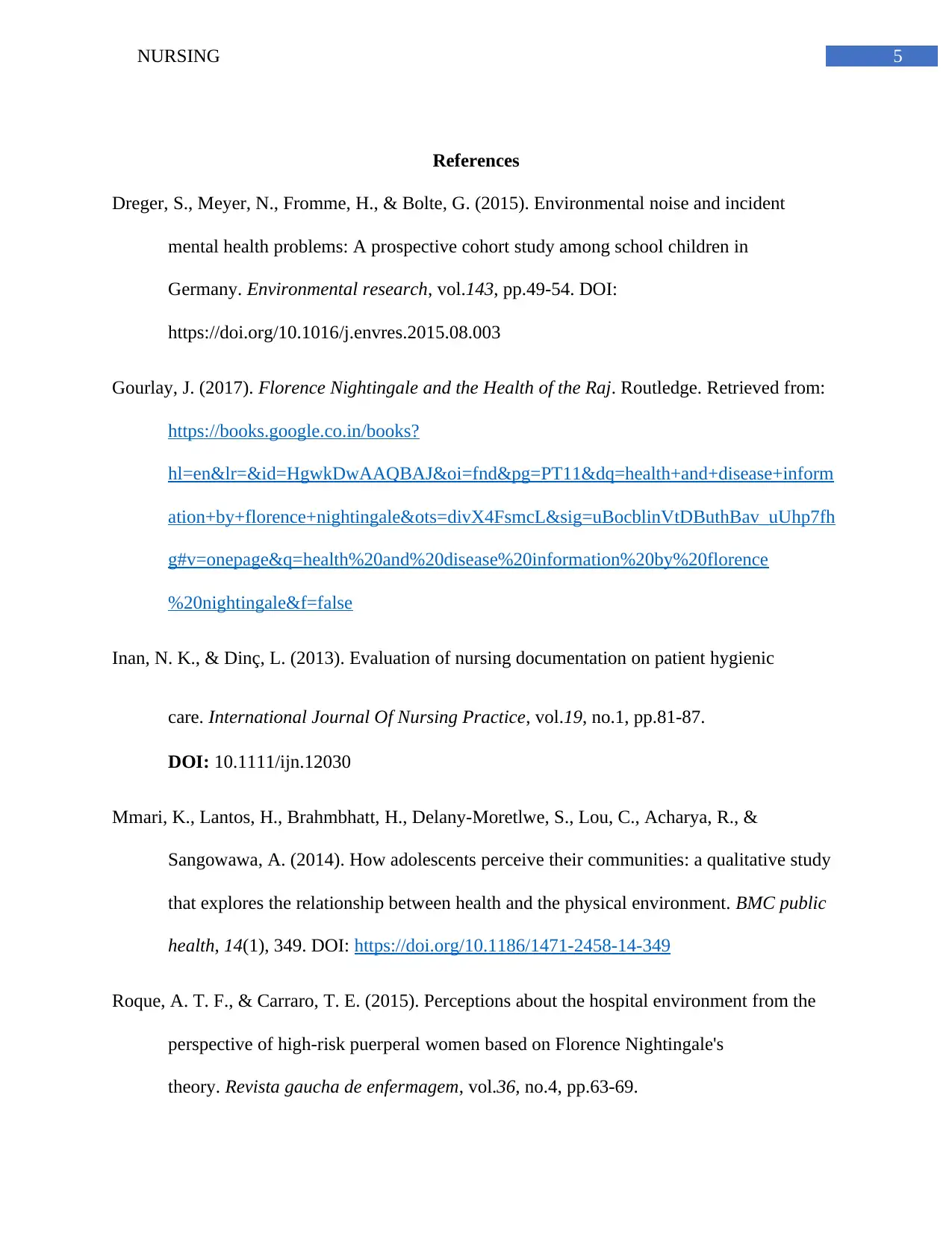
5NURSING
References
Dreger, S., Meyer, N., Fromme, H., & Bolte, G. (2015). Environmental noise and incident
mental health problems: A prospective cohort study among school children in
Germany. Environmental research, vol.143, pp.49-54. DOI:
https://doi.org/10.1016/j.envres.2015.08.003
Gourlay, J. (2017). Florence Nightingale and the Health of the Raj. Routledge. Retrieved from:
https://books.google.co.in/books?
hl=en&lr=&id=HgwkDwAAQBAJ&oi=fnd&pg=PT11&dq=health+and+disease+inform
ation+by+florence+nightingale&ots=divX4FsmcL&sig=uBocblinVtDButhBav_uUhp7fh
g#v=onepage&q=health%20and%20disease%20information%20by%20florence
%20nightingale&f=false
Inan, N. K., & Dinç, L. (2013). Evaluation of nursing documentation on patient hygienic
care. International Journal Of Nursing Practice, vol.19, no.1, pp.81-87.
DOI: 10.1111/ijn.12030
Mmari, K., Lantos, H., Brahmbhatt, H., Delany-Moretlwe, S., Lou, C., Acharya, R., &
Sangowawa, A. (2014). How adolescents perceive their communities: a qualitative study
that explores the relationship between health and the physical environment. BMC public
health, 14(1), 349. DOI: https://doi.org/10.1186/1471-2458-14-349
Roque, A. T. F., & Carraro, T. E. (2015). Perceptions about the hospital environment from the
perspective of high-risk puerperal women based on Florence Nightingale's
theory. Revista gaucha de enfermagem, vol.36, no.4, pp.63-69.
References
Dreger, S., Meyer, N., Fromme, H., & Bolte, G. (2015). Environmental noise and incident
mental health problems: A prospective cohort study among school children in
Germany. Environmental research, vol.143, pp.49-54. DOI:
https://doi.org/10.1016/j.envres.2015.08.003
Gourlay, J. (2017). Florence Nightingale and the Health of the Raj. Routledge. Retrieved from:
https://books.google.co.in/books?
hl=en&lr=&id=HgwkDwAAQBAJ&oi=fnd&pg=PT11&dq=health+and+disease+inform
ation+by+florence+nightingale&ots=divX4FsmcL&sig=uBocblinVtDButhBav_uUhp7fh
g#v=onepage&q=health%20and%20disease%20information%20by%20florence
%20nightingale&f=false
Inan, N. K., & Dinç, L. (2013). Evaluation of nursing documentation on patient hygienic
care. International Journal Of Nursing Practice, vol.19, no.1, pp.81-87.
DOI: 10.1111/ijn.12030
Mmari, K., Lantos, H., Brahmbhatt, H., Delany-Moretlwe, S., Lou, C., Acharya, R., &
Sangowawa, A. (2014). How adolescents perceive their communities: a qualitative study
that explores the relationship between health and the physical environment. BMC public
health, 14(1), 349. DOI: https://doi.org/10.1186/1471-2458-14-349
Roque, A. T. F., & Carraro, T. E. (2015). Perceptions about the hospital environment from the
perspective of high-risk puerperal women based on Florence Nightingale's
theory. Revista gaucha de enfermagem, vol.36, no.4, pp.63-69.
⊘ This is a preview!⊘
Do you want full access?
Subscribe today to unlock all pages.

Trusted by 1+ million students worldwide
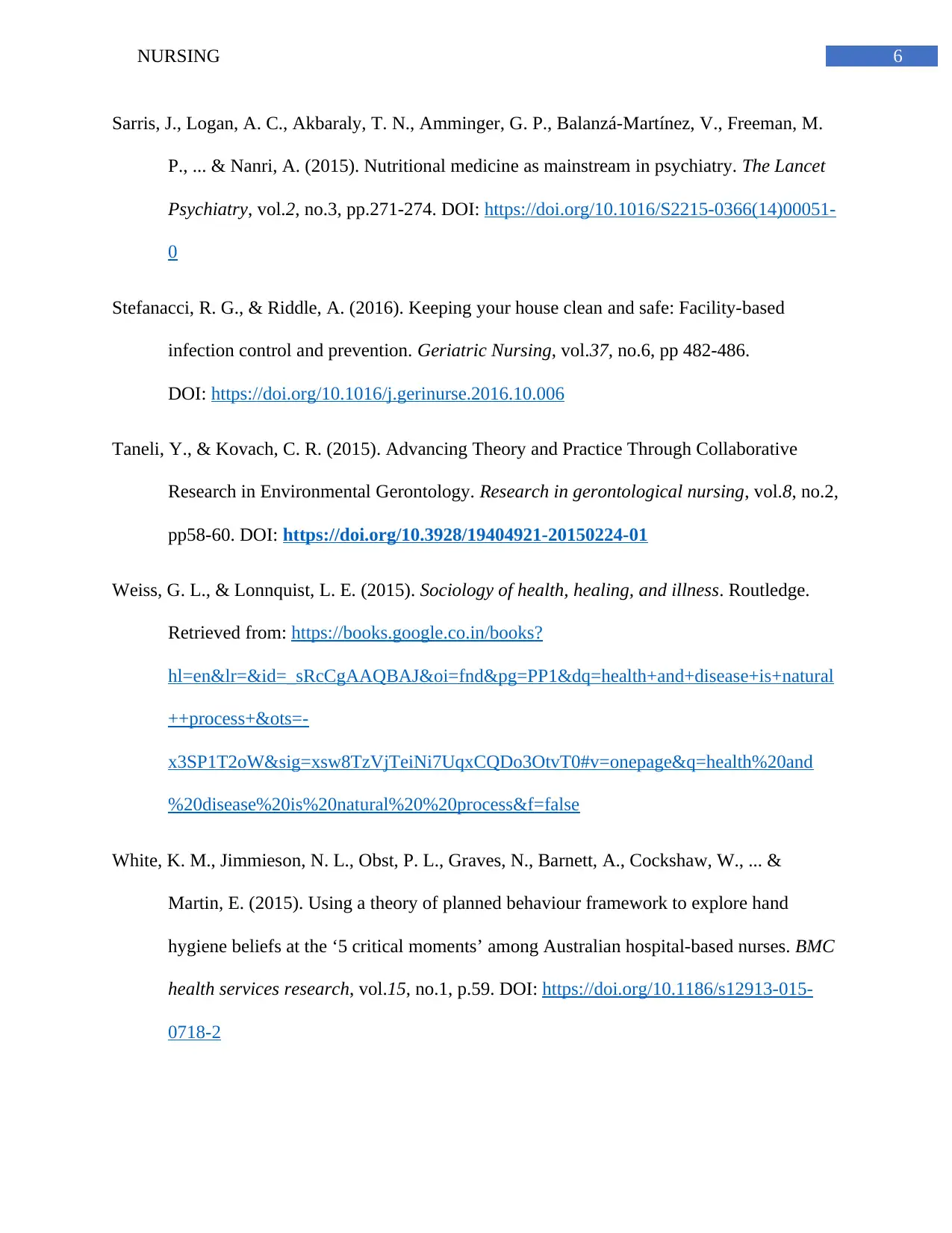
6NURSING
Sarris, J., Logan, A. C., Akbaraly, T. N., Amminger, G. P., Balanzá-Martínez, V., Freeman, M.
P., ... & Nanri, A. (2015). Nutritional medicine as mainstream in psychiatry. The Lancet
Psychiatry, vol.2, no.3, pp.271-274. DOI: https://doi.org/10.1016/S2215-0366(14)00051-
0
Stefanacci, R. G., & Riddle, A. (2016). Keeping your house clean and safe: Facility-based
infection control and prevention. Geriatric Nursing, vol.37, no.6, pp 482-486.
DOI: https://doi.org/10.1016/j.gerinurse.2016.10.006
Taneli, Y., & Kovach, C. R. (2015). Advancing Theory and Practice Through Collaborative
Research in Environmental Gerontology. Research in gerontological nursing, vol.8, no.2,
pp58-60. DOI: https://doi.org/10.3928/19404921-20150224-01
Weiss, G. L., & Lonnquist, L. E. (2015). Sociology of health, healing, and illness. Routledge.
Retrieved from: https://books.google.co.in/books?
hl=en&lr=&id=_sRcCgAAQBAJ&oi=fnd&pg=PP1&dq=health+and+disease+is+natural
++process+&ots=-
x3SP1T2oW&sig=xsw8TzVjTeiNi7UqxCQDo3OtvT0#v=onepage&q=health%20and
%20disease%20is%20natural%20%20process&f=false
White, K. M., Jimmieson, N. L., Obst, P. L., Graves, N., Barnett, A., Cockshaw, W., ... &
Martin, E. (2015). Using a theory of planned behaviour framework to explore hand
hygiene beliefs at the ‘5 critical moments’ among Australian hospital-based nurses. BMC
health services research, vol.15, no.1, p.59. DOI: https://doi.org/10.1186/s12913-015-
0718-2
Sarris, J., Logan, A. C., Akbaraly, T. N., Amminger, G. P., Balanzá-Martínez, V., Freeman, M.
P., ... & Nanri, A. (2015). Nutritional medicine as mainstream in psychiatry. The Lancet
Psychiatry, vol.2, no.3, pp.271-274. DOI: https://doi.org/10.1016/S2215-0366(14)00051-
0
Stefanacci, R. G., & Riddle, A. (2016). Keeping your house clean and safe: Facility-based
infection control and prevention. Geriatric Nursing, vol.37, no.6, pp 482-486.
DOI: https://doi.org/10.1016/j.gerinurse.2016.10.006
Taneli, Y., & Kovach, C. R. (2015). Advancing Theory and Practice Through Collaborative
Research in Environmental Gerontology. Research in gerontological nursing, vol.8, no.2,
pp58-60. DOI: https://doi.org/10.3928/19404921-20150224-01
Weiss, G. L., & Lonnquist, L. E. (2015). Sociology of health, healing, and illness. Routledge.
Retrieved from: https://books.google.co.in/books?
hl=en&lr=&id=_sRcCgAAQBAJ&oi=fnd&pg=PP1&dq=health+and+disease+is+natural
++process+&ots=-
x3SP1T2oW&sig=xsw8TzVjTeiNi7UqxCQDo3OtvT0#v=onepage&q=health%20and
%20disease%20is%20natural%20%20process&f=false
White, K. M., Jimmieson, N. L., Obst, P. L., Graves, N., Barnett, A., Cockshaw, W., ... &
Martin, E. (2015). Using a theory of planned behaviour framework to explore hand
hygiene beliefs at the ‘5 critical moments’ among Australian hospital-based nurses. BMC
health services research, vol.15, no.1, p.59. DOI: https://doi.org/10.1186/s12913-015-
0718-2
Paraphrase This Document
Need a fresh take? Get an instant paraphrase of this document with our AI Paraphraser

7NURSING
1 out of 8
Related Documents
Your All-in-One AI-Powered Toolkit for Academic Success.
+13062052269
info@desklib.com
Available 24*7 on WhatsApp / Email
![[object Object]](/_next/static/media/star-bottom.7253800d.svg)
Unlock your academic potential
Copyright © 2020–2025 A2Z Services. All Rights Reserved. Developed and managed by ZUCOL.





